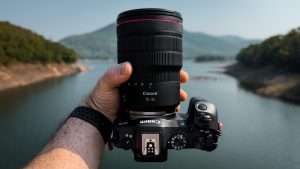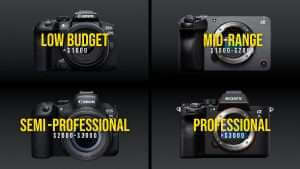The WeeBill S is not my first gimbal from Zhiyun’s WeeBill series. I already bought the WeeBill Lab directly when it came out. So when Zhiyun sent me the WeeBill S for testing it, I was mostly interested in how it is better compared to the WeeBill Lab.
Design
Overall I must say that both WeeBills so far are my favorite gimbals on the market. This is simply due to their design.
Having the option to attach the handle to the back of the gimbal for underslung mode makes it incredibly easy to use. This design also allows the gimbals to be extremely small. So they easily fit in- or outside your backpack.
The buttons are placed well, so you can easily make adjustments while using the gimbal. The WeeBill S also lets you lock the buttons, so that you don’t press them accidentally, what would usually happen a lot.
The actual gimbal part on top allows seeing your screen perfectly as the back motor is not placed too high.
What’s also great is that the WeeBill S comes with a small tripod, so you can easily put it everywhere. You can also easily mount it on other tripods. So it’s pretty flexible.
Using the tripod comes in handy when you calibrate the gimbal. As you can lock every achs, you can calibrate only one achs at the time. That makes calibrating it a breeze. Even beginners won’t have any problems doing that.
The WeeBill S has some nice screws to make adjustments to the gimbal. You can lose and tighten them without any tools and they are easy to reach. However, when you mount your camera in the wrong position, you can adjust the back screw anymore. So keep that in mind before you mount your camera on the baseplate.
Motors
A big improvement of the WeeBill S over the WeeBill Lab is the motor strength and position of the back motor. Zhiyun doesn’t write exactly what’s the max weight it can carry. But from my tests, I would say that it can carry pretty much every setup. Especially setups with longer lenses are now possible as the back motor has been moved further backward.
My heaviest setup was the Panasonic GH5 together with the SIGMA 18-35mm F1.8 lens and Viltrox EF-M2 speed booster. This setup is not only heavy but puts a lot of weight on the front. So it was not possible to balance it on the Lab, but on the S it actually worked pretty well for most shots.
Only when I shot in a certain angle in underslung mode, this camera/lens combination caused some slight motor-jitters. But that wasn’t a big issue as I could easily get a bit lower with my hands to change the angle and it worked. So I was able to get the shot I want. I just had to change how I hold the gimbal a bit.
So overall, the WeeBill Ss motors are a great improvement over the WeeBill S. I can say that it will hold every mirrorless camera and most DSLRs. So it’s perfect, even if you have a bit heavier setup.
Motor strength calibration
Adjusting the gimbal to the correct motor strength got so much easier with the S! On the Lab, you had to kinda guess what’s the correct motor strength and if you set it wrong, it could ruin your shot.
For example, I had the motor strength set a bit too high when I shot a hyper-lapse at the entrance of Angkor Wat at the beginning of 2019. So the Lab always panned the camera to the left while I was walking forward. So I had to turn it to the right all the time to compensate for that and needed a lot of post-production work to stabilize it… Later I found out that I just had to lower the motor strength to make it work.
On the WeeBill S, you can simply choose auto in the menu and after running some tests for a few seconds, it automatically chooses the right motor strength. That’s a big improvement and when I shot hyper-lapses after doing that, I had no issues at all.
Shooting Modes
The WeeBill S offers 6 shooting modes (Pan Follow/Follow, Lock, POV, Vortex, Selfie & Go). As these modes were already available on the WeeBill Lab and other gimbals, I don’t want to get in-depth here. But knowing that you have all the necessary modes available is important as you don’t want to be limited.
The vortex mode, however, wasn’t introduced too long ago. This mode is very cool and allow for interesting shots. However, my most used modes are Pan Follow & Lock.
TransMount Image Transmission Module
One big new feature of the WeeBill S is the new image transmission module. You can attach this module to the gimbal and connect it to your camera and the gimbal. It then streams the video directly to your phone or an external monitor that you can connect via a receiver.
That allows some great features, like false color, focus peaking, waveform monitor, etc. And it also makes controlling the gimbal and camera from your smartphone possible. You can even let the gimbal mirror the movements of your smartphone using Sync Motion.
SmartFollow 2.0
A feature that I was pretty excited for, is SmartFollow 2.0. It comes with the TransMount Image Transmission Module. This feature definitely makes the old object tracking from Zhiyun a lot better, but it’s still not perfect.
On the WeeBill Lab, it only started moving the gimbal when the tracked subject was close hitting the frame of the screen (at least at the time when I tested it), which made it unusable.
With the WeeBill S, that got a lot better. I was able to shoot a decent hyper-lapse with it where the main subject (a Buddhist temple) was aside from me. It tracked it quite good, but there were still some bumps, so I had to stabilize it a bit more using DaVinci Resolve. But it kept the subject very good in the center of the frame. So I can definitely recommend it for that.
However, I also did another test where I drove with my motorbike and tried to track myself. In this case, the result wasn’t usable. It just tracked me way too slow.
But I think that this was a result of the transmission. I had to be a bit further away from the transmission module. So at first, I lost connection at about 40-50 meters. When I got a bit closer, I had a connection, but it seemed to be slow. So that’s probably why it didn’t track me properly.
I think it’s just not possible to achieve better results with a smartphone as the phone’s WiFi range is a bit limited. The TransMount Image Transmission Receiver should make that a lot better (just my thought, didn’t test it yet).
You can also use this feature to track yourself while speaking into the camera. That’s interesting for documentaries where you talk about the place you’re filming in. For that, the tracking works perfectly.
So overall, the tracking is now at a usable level. Thanks a lot to Zhiyun for that improvement.
But please don’t stop working on it, as especially the tracking for hyper-lapses (long walks while tracking a steady subject) could still be a bit smoother. I know, that’s very complicated, but that could make the gimbal stand out even more for travel video creators like myself.
Professional usage
Apart from the SmartFollow feature, I don’t find many use cases for the transmission module for travel video creators. Instead, it takes a lot more set up time.
But if you don’t only create travel videos and you often go on professional shoots with a crew, it’s actually a very nice new feature. It allows you to monitor different cameras on gimbals at the same time and you can even make real-time adjustments.
You can also mount the gimbal to cars or other vehicles and then control it entirely with your phone. That allows for a lot of very creative shots that wow your clients.
So if you do some professional work, the transmission module can definitely make your videos a lot better.
If you’re a normal travel video creator, you should think about what shots you want to make and if it can add some value to it.
Consider that without this module, you can’t wirelessly control the gimbal anymore, as it was on the WeeBill Lab. I would personally prefer it if Zhiyun would give us both options. Having a wireless connection to the app with some basic features without the transmission module and extended features with the transmission module.
Conclusion
In my opinion, the WeeBill S is not just an upgrade, but more like another gimbal aside from the WeeBill S. Depending on the weight and size of your camera and lens and what wireless controlling features you need, you can buy the one or the other. Both are great gimbals with different strengths. The price difference is also not too big.
Overall, the WeeBill S can make more sense in the long run as it’s newer. So it’s resale value should be a bit higher in a few years.










